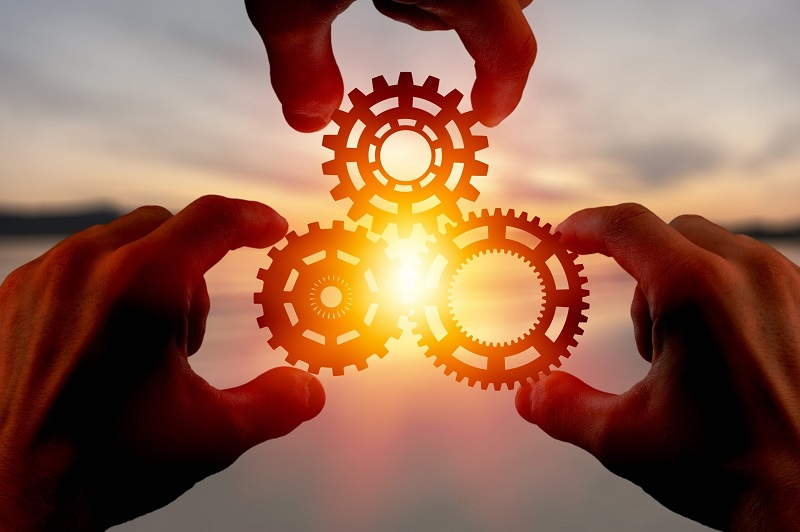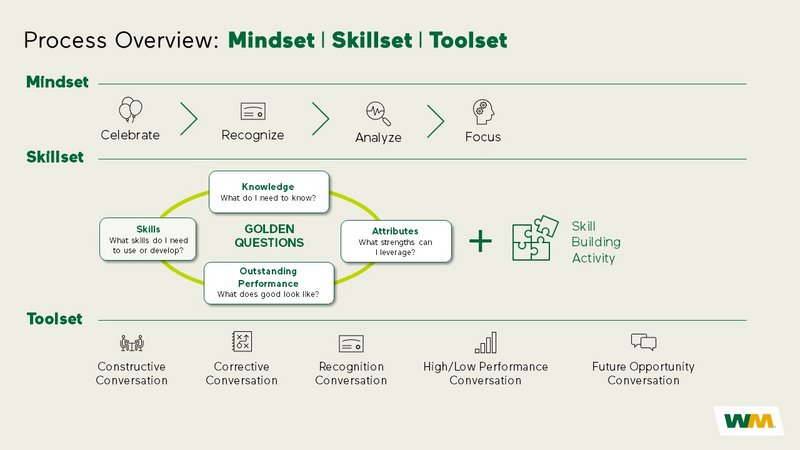ATD Blog
Mindset, Skill Set, Toolset—the WM Approach
Mon Sep 11 2023

At WM, we’ve learned the benefits of focusing not only on the employee’s skill set but also their toolset and, most importantly, their mindset. We believe that focusing on all three is crucial for individuals and organizations to thrive in a rapidly evolving and competitive landscape.
From a learning and development perspective, mindset, skill set, and toolset are three interconnected elements that contribute to a training program’s success. Here’s a breakdown of each term and their significance in designing a learning and development program:
Mindset: Mindset refers to the attitudes, beliefs, and perspectives individuals hold, which shape their approach to learning and their ability to adapt and grow. It encompasses the mental frameworks, motivations, and resilience influencing people’s perceptions of challenges and opportunities. A growth mindset, characterized by a willingness to learn, embrace challenges, and persist through setbacks, is highly valuable in learning. Developing a growth mindset fosters a culture of continuous learning and improvement.
Skill set: Skill set refers to individuals’ specific abilities, competencies, and expertise in a particular area. It includes both technical skills and soft skills. Technical skills are job-specific proficiencies acquired through education, training, and experience, such as coding, data analysis, or project management. However, soft skills are interpersonal and communication abilities, critical thinking, problem-solving, leadership, and teamwork skills. Identifying the required skill set for a particular learning program ensures that learners acquire the knowledge and abilities necessary to perform effectively in their roles.
Toolset: Toolset refers to the tools, technologies, methodologies, and resources that individuals can leverage to accomplish tasks, solve problems, and achieve goals. In the context of learning programs, toolset encompasses the training materials, software, equipment, and other resources needed to support learning. This could include e-learning platforms, simulations, hands-on exercises, case studies, or mentorship programs. Providing an appropriate toolset ensures that learners have the necessary resources to acquire and apply their skills effectively.
Integrating Mindset, Skill Set, and Toolset Into Learning Programs
When designing a learning program, the structure often revolves around these three elements:
1. Assessing and developing the right mindset: The program should aim to cultivate a growth mindset among participants. This can be achieved through activities that promote self-reflection, resilience, and a positive learning attitude. It may include setting clear expectations, emphasizing the value of continuous learning, and providing opportunities for self-assessment and feedback.
2. Identifying and building the required skill set: The program should clearly define the skills participants need to acquire or enhance. This involves conducting a skills gap analysis to identify areas for improvement and designing learning objectives aligned with the desired outcomes. Activities, such as lectures, workshops, practical exercises, and role-playing, can then be tailored to develop the specific skill set required.
3. Providing the necessary toolset: The program should offer appropriate resources and tools to support learning and skill development. This includes selecting and providing access to relevant training materials, technologies, and platforms. Additionally, incorporating hands-on experiences, real-world simulations, and mentorship opportunities can help participants apply their skills and build confidence in using the toolset effectively.
By integrating mindset, skill set, and toolset into the structure of a learning program, organizations can create a comprehensive learning experience that promotes growth, equips participants with essential skills, and provides the necessary resources for success.
In a world of constant change, a growth mindset empowers individuals to embrace new technologies, learn new skills, and adapt to changing circumstances, ultimately enhancing their performance and driving innovation within organizations.
Moreover, organizations that focus on developing skill set, toolset, and mindset create a culture of continuous learning and improvement. They foster an environment where employees are empowered to acquire new skills, leverage advanced tools and technologies, and cultivate a growth-oriented mindset. This, in turn, enables organizations to stay agile, adapt to industry trends, and thrive in a dynamic business landscape.
In Practice at WM
As teams and departments embark on their journey toward optimization, developing a mindset becomes the crucial first step in preparing employees for technology adoption and fostering continuous learning, curiosity, and adaptability.
At WM, we recognize the importance of mindset in embracing change and overcoming the challenges that come with new technologies. To cultivate a confident mindset, we prioritize creating a growth culture and helping employees recognize the value they bring to the company’s goals. Just as mindset matters in fitness training, playing an instrument, or learning any skill, the learning initiatives at WM emphasize the significance of mindset training.
We offer a curated marketplace of learning programs, dedicated career coaches, and tools to explore career pathways, providing opportunities for employees to acquire new skills and knowledge. Additionally, we incorporate self-reflection activities, mentor coaching, peer-to-peer collaboration, and knowledge-sharing platforms to support employees in developing the right mindset. By blending various methodologies such as workshops, seminars, online courses, and mentorship programs, we ensure that our learners stay motivated even when faced with difficulties. For example, they can reach out to their mentors or utilize social learning platforms to maintain high spirits, enhance engagement, and stay focused when challenges inevitably arise.
While mindset refers to how one thinks, skill set represents the actions one takes, and toolset encompasses the systems and tools used (see illustration as an example). Keeping these three in perspective at WM, we follow agile methods and Minimal Viable Product (MVP) approaches in preparing employees for technology adoption.
These methodologies focus on rapid prototyping, iterative development, and user-centered design, enabling the technology and business teams to identify and address potential challenges early in the adoption process. For instance, when teams need to adopt a new tool or process, we collaborate with the end users and start by developing a simplified version of a product or service with just enough features to satisfy early adopters. This approach allows us to test the viability of a technology before investing significant resources in its development and implementation. By doing so, we can identify potential challenges, gather user feedback, document lessons learned, and address them early in the adoption process, ensuring a smoother transition for a broader set of employees.
In the realm of technology enablement, less is often more! For example, our customer experience teams benefit from standardized customer processes, self-serve website features, and chatbot capabilities, while our post-collection teams are enabled by automating surface emissions and daily heavy equipment inspections. These initiatives not only automate most tasks but also upskill and future-skill these roles. We create and build blended programs and on-demand training options, such as short video snippets and online modules accessible via any device, anytime, anywhere.
We also incorporate tools to reinforce learning in the flow of work, empowering teams. Following the 70-20-10 model, our learning interventions allow learners to gain 70 percent of their knowledge from job-related experiences, including on-the-job learning activities, demos, scenario-based approaches to discover and refine their job-related skills, make decisions, and address challenges. They gain 20 percent of their knowledge from interactions with others and 10 percent from formal educational events.
At WM, we are rethinking training, recognizing that the mindset, skill set, and toolset can make a difference between an average learning experience and a stellar one. Overall, a balanced development approach that encompasses skill set, toolset, and mindset is crucial for individuals and organizations to remain competitive, drive innovation, and foster a culture of growth and resilience.

What We Look for in a Learning Mindset
1. Embracing challenges: Individuals with a learning mindset see challenges as opportunities for growth rather than obstacles to avoid. They are willing to step out of their comfort zones, take on new tasks, and view setbacks as learning experiences.
2. Persistence and resilience: People with a learning mindset understand that learning requires effort and perseverance. They bounce back from failures, setbacks, or criticism, and they are motivated to keep trying, even when faced with obstacles.
3. Curiosity and open-mindedness: A learning mindset is driven by curiosity and a genuine desire to explore and discover new things. Individuals with this mindset are open to new ideas, perspectives, and feedback. They seek knowledge and continuously ask questions.
4. Embracing feedback: Those with a learning mindset value feedback as an opportunity to improve. They see feedback as constructive input rather than personal criticism. They actively seek feedback, reflect on it, and use it to adjust and grow.
5. Effort and growth: People with a learning mindset believe that intelligence and abilities can be developed through effort and practice. They understand that improvement comes with dedicated learning and hard work, rather than relying solely on innate talent.
6. Learning from others: Individuals with a learning mindset recognize the value of learning from others. They seek mentors, collaborators, and experts in their fields to learn from their experiences and insights.
7. Flexibility and adaptability: A learning mindset involves being flexible and adaptable in the face of change. It requires a willingness to adjust strategies, embrace new technologies, and adapt to evolving circumstances.
8. Lifelong learning: People with a learning mindset understand that learning is a lifelong journey, and they embrace continuous learning as a fundamental aspect of personal and professional development. They seek opportunities for growth and self-improvement.
